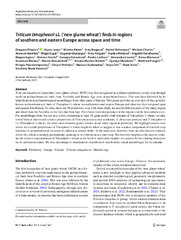Приказ основних података о документу
Triticum timopheevii s.l. (‘new glume wheat’) finds in regions of southern and eastern Europe across space and time
| dc.creator | Filipović, Dragana | |
| dc.creator | Jones, Glynis | |
| dc.creator | Kirleis, Wiebke | |
| dc.creator | Bogaard, Amy | |
| dc.creator | Ballantyne, Rachel | |
| dc.creator | Charles, Michael | |
| dc.creator | de Vareilles, Anne | |
| dc.creator | Ergun, Müge | |
| dc.creator | Gkatzogia, Eugenia | |
| dc.creator | Holguin, Amy | |
| dc.creator | Hristova, Ivanka | |
| dc.creator | Karathanou, Angeliki | |
| dc.creator | Kapcia, Magda | |
| dc.creator | Knežić, Dolores | |
| dc.creator | Kotzamani, Georgia | |
| dc.creator | Lathiras, Pavlos | |
| dc.creator | Livarda, Alexandra | |
| dc.creator | Marinova, Elena | |
| dc.creator | Michou, Stavroula | |
| dc.creator | Mosulishvili, Marine | |
| dc.creator | Mueller-Bieniek, Aldona | |
| dc.creator | Obradović, Djurdja | |
| dc.creator | Padgett, Matthew | |
| dc.creator | Paraskevopoulou, Pelagia | |
| dc.creator | Petridou, Chryssi | |
| dc.creator | Stylianakou, Haroula | |
| dc.creator | Zerl, Tanja | |
| dc.creator | Vidas, Doris | |
| dc.creator | Valamoti, Soultana Maria | |
| dc.date.accessioned | 2023-11-23T11:32:40Z | |
| dc.date.available | 2023-11-23T11:32:40Z | |
| dc.date.issued | 2023 | |
| dc.identifier.uri | http://rai.ai.ac.rs/handle/123456789/934 | |
| dc.description.abstract | Triticum timopheevii sensu lato (‘new glume wheat’, NGW) was first recognised as a distinct prehistoric cereal crop through work on archaeobotanical finds from Neolithic and Bronze Age sites in northern Greece. This was later followed by its identification in archaeobotanical assemblages from other parts of Europe. This paper provides an overview of the currently known archaeobotanical finds of Timopheev’s wheat in southeastern and eastern Europe and observes their temporal span and spatial distribution. To date, there are 89 prehistoric sites with these finds, located in different parts of the study region and dated from the Neolithic to the very late Iron Age. Their latest recorded presence in the region is in the last centuries BCE. For assemblages from the site as a whole containing at least 30 grain and/or chaff remains of Timopheev’s wheat, we take a brief look at the overall relative proportions of Triticum monococcum (einkorn), T. dicoccum (emmer) and T. timopheevii s.l. (Timopheev’s wheat), the three most common glume wheats in our study region in prehistory. We highlight several sites where the overall proportions of Timopheev’s wheat might be taken to suggest it was a minor component of a mixed crop (maslin), or an unmonitored inclusion in einkorn or emmer fields. At the same sites, however, there are also discrete contexts where this wheat is strongly predominant, pointing to its cultivation as a pure crop. We therefore emphasise the need to evaluate the relative representation of Timopheev’s wheat at the level of individual samples or contexts before making inferences on its cultivation status. We also encourage re-examination of prehistoric and historic cereal assemblages for its remains. | sr |
| dc.language.iso | en | sr |
| dc.publisher | Springer Nature | sr |
| dc.relation | info:eu-repo/grantAgreement/MESTD/Basic Research (BR or ON)/177020/RS// | sr |
| dc.relation | Open Access funding enabled and organized by Projekt DEAL. Funding for some of the research projects contributing to this study was provided by the European Research Council (ERC), Deutsche Forschungsgemeinschaft (DFG), Fonds zur Förderung der wissenschaftlichen Forschung (FWF, Austrian Science Fund) and Ministry of Culture of the Republic of Serbia. The paper is a product of the ERC-project ‘PlantCult: Investigating the Plant Food Cultures of Ancient Europe’ (CoG 682529), Aristotle University of Thessaloniki, Greece; the ERC-project ‘EXPLO: Exploring the dynamics and causes of prehistoric land use change in the cradle of European farming’ (SyG 810586), University of Oxford, UK; the Collaborative Research Centre ‘Scales of Transformation in Prehistoric and Archaic Societies’ (DFG-Ref. 2901391021-SFB1266) and the Excellence Cluster EXC2150 ‘ROOTS: Social, Environmental and Cultural Connectivity in Past Societies’ (DFG-Ref. 390870439), both of Kiel University, Germany. | sr |
| dc.rights | openAccess | sr |
| dc.rights.uri | https://creativecommons.org/licenses/by/4.0/ | |
| dc.source | Vegetation History and Archaeobotany | sr |
| dc.subject | Triticum timopheevii | sr |
| dc.subject | Prehistory | sr |
| dc.subject | Europe | sr |
| dc.subject | Cereals | sr |
| dc.subject | Maslin crop | sr |
| dc.title | Triticum timopheevii s.l. (‘new glume wheat’) finds in regions of southern and eastern Europe across space and time | sr |
| dc.type | article | sr |
| dc.rights.license | BY | sr |
| dc.identifier.doi | 10.1007/s00334-023-00954-w | |
| dc.identifier.fulltext | http://rai.ai.ac.rs/bitstream/id/2391/Download.pdf | |
| dc.identifier.scopus | 2-s2.0-85173991460 | |
| dc.type.version | publishedVersion | sr |


